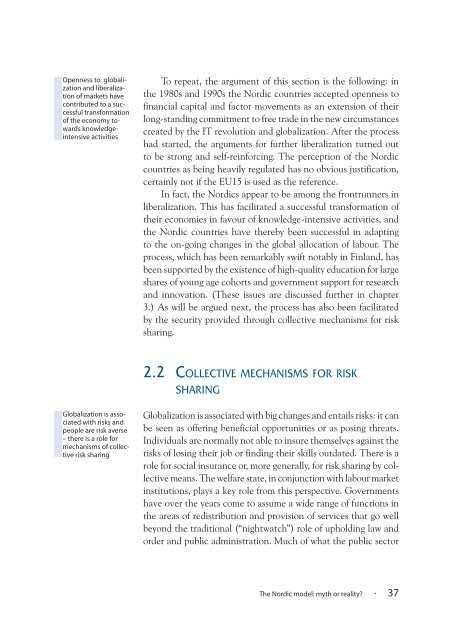The Nordic Model - Embracing globalization and sharing risks
The Nordic Model - Embracing globalization and sharing risks
The Nordic Model - Embracing globalization and sharing risks
You also want an ePaper? Increase the reach of your titles
YUMPU automatically turns print PDFs into web optimized ePapers that Google loves.
Openness to <strong>globalization</strong><br />
<strong>and</strong> liberalization<br />
of markets have<br />
contributed to a successful<br />
transformation<br />
of the economy towards<br />
knowledgeintensive<br />
activities<br />
To repeat, the argument of this section is the following: in<br />
the 1980s <strong>and</strong> 1990s the <strong>Nordic</strong> countries accepted openness to<br />
financial capital <strong>and</strong> factor movements as an extension of their<br />
long-st<strong>and</strong>ing commitment to free trade in the new circumstances<br />
created by the IT revolution <strong>and</strong> <strong>globalization</strong>. After the process<br />
had started, the arguments for further liberalization turned out<br />
to be strong <strong>and</strong> self-reinforcing. <strong>The</strong> perception of the <strong>Nordic</strong><br />
countries as being heavily regulated has no obvious justification,<br />
certainly not if the EU15 is used as the reference.<br />
In fact, the <strong>Nordic</strong>s appear to be among the frontrunners in<br />
liberalization. This has facilitated a successful transformation of<br />
their economies in favour of knowledge-intensive activities, <strong>and</strong><br />
the <strong>Nordic</strong> countries have thereby been successful in adapting<br />
to the on-going changes in the global allocation of labour. <strong>The</strong><br />
process, which has been remarkably swift notably in Finl<strong>and</strong>, has<br />
been supported by the existence of high-quality education for large<br />
shares of young age cohorts <strong>and</strong> government support for research<br />
<strong>and</strong> innovation. (<strong>The</strong>se issues are discussed further in chapter<br />
3.) As will be argued next, the process has also been facilitated<br />
by the security provided through collective mechanisms for risk<br />
<strong>sharing</strong>.<br />
2.2 COLLECTIVE MECHANISMS FOR RISK<br />
SHARING<br />
Globalization is associated<br />
with <strong>risks</strong> <strong>and</strong><br />
people are risk averse<br />
– there is a role for<br />
mechanisms of collective<br />
risk <strong>sharing</strong><br />
Globalization is associated with big changes <strong>and</strong> entails <strong>risks</strong>: it can<br />
be seen as offering beneficial opportunities or as posing threats.<br />
Individuals are normally not able to insure themselves against the<br />
<strong>risks</strong> of losing their job or finding their skills outdated. <strong>The</strong>re is a<br />
role for social insurance or, more generally, for risk <strong>sharing</strong> by collective<br />
means. <strong>The</strong> welfare state, in conjunction with labour market<br />
institutions, plays a key role from this perspective. Governments<br />
have over the years come to assume a wide range of functions in<br />
the areas of redistribution <strong>and</strong> provision of services that go well<br />
beyond the traditional (“nightwatch”) role of upholding law <strong>and</strong><br />
order <strong>and</strong> public administration. Much of what the public sector<br />
<strong>The</strong> <strong>Nordic</strong> model: myth or reality? · 37

















